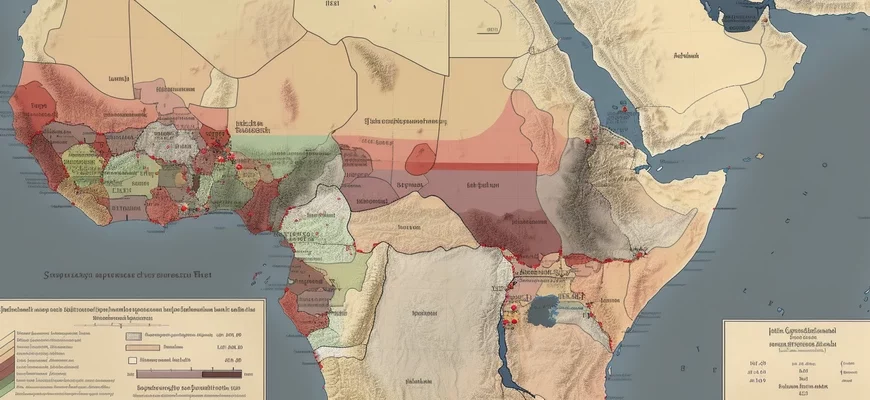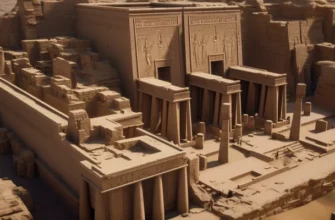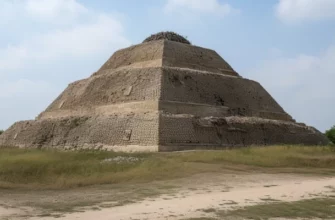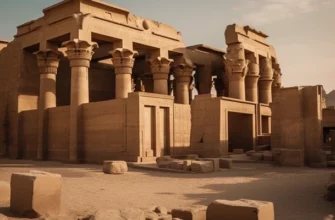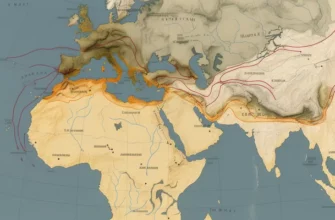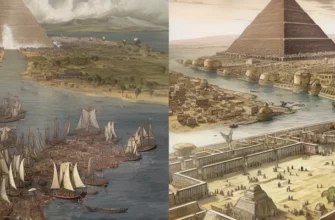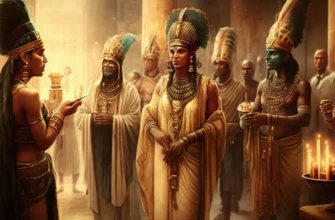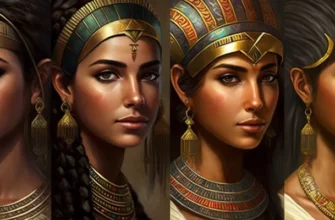The First Intermediate Period is an era of Egyptian history that lasted from the middle of the 23rd century to the middle of the 21st century BC. This period followed the end of Ancient Egypt and preceded the beginning of Middle Egypt.
This transitional period was characterized by political and social instability in Egypt. Frequent changes in power and struggles between different regions of the country led to the collapse of the Egyptian state into several independent territories.
Cultural changes also took place during the First Intermediate Period. For example, writing evolved from hieroglyphics to hieratic and demotic writing, which simplified written communication and made it more accessible to a wider range of people.
The First Intermediate Period ended in the middle of the 21st century BC with the advent of the Second Intermediate Period, when Egypt was reunited under the rule of the Pharaohs.
- Precursors to the transitional period
- Causes of political instability
- Social and political life during the transition period
- The emergence of the “Second Intermediate Period”
- The role of various rulers and dynasties in the transitional period
- Major events and achievements of the transitional period
- Consequences of the transitional period
Precursors to the transitional period
The precursors to the transitional period of the Egyptian state, which lasted from the middle of the 23rd to the middle of the 21st century BC, include:
Climate change: Over the past millennia, Egypt has experienced noticeable climate fluctuations. The country became more arid, which affected soil irrigation and the availability of sufficient water for plant growth. This may be the reason why some regions of Egypt became less fertile and agriculture became less productive.
Economic difficulties: Egypt also experienced economic difficulties during this period, which were linked to a decline in trade and production of goods. This led to the country’s economy beginning to weaken, which may have affected the stability of the state.
Political instability: Growing political instability also contributed to the beginning of the transitional period of the Egyptian state. Military conflicts between different regions of the country forced many local rulers to change their political and military alliances.
Changing social conditions: Growing social inequality may also have contributed to the transitional period. Large landowners and the priestly class became even more influential, while poorer segments of the population experienced increasing inequality and restrictions on their social and economic rights.
These factors together caused changes in the political system and social structure of Egypt, which were reflected in the transition period. Starting in the mid-23rd century BCE, nomadic tribes visited the country, causing social and political changes. During this period, various states were created that competed with each other for power and resources. The most famous of these is the state of the Hyksos, which was conquered by Egypt at the end of the transitional period.
The transitional period is also reflected in the architecture, art, and culture of Egypt. For example, new forms of writing, new religious and cultural traditions, and new forms of architecture and sculpture appeared during this period. According to researchers, this indicates that the transitional period was a period of innovation and change that laid the foundation for the further development of the Egyptian state.
The collapse of Ancient Egypt, which took place during the transitional period (mid-23rd to mid-21st century), was the result of several factors that contributed to the decline of the state.
One of these factors was the uprisings and struggles between different factions of power. This led to political instability and a deterioration of the economic situation in the country. Against the backdrop of these events, Egypt began to lose its territorial integrity, in particular, some lands were conquered by nomadic tribes.
Another factor was external threats, in particular, attacks by nomadic tribes, including the Hyksos, who were stronger and more organized than the Egyptian army. The Hyksos managed to capture part of Egypt and establish their rule in these territories.
Another important reason was the economic crisis associated with a decline in production and an increase in taxes. This led to a decline in the standard of living of the population and the emergence of famine.
As a result of these factors, Ancient Egypt collapsed and its power was subjugated by the Hyksos, who ruled Egypt for the next 150 years. However, this period was followed by the New Kingdom period, during which Egypt restored its power and culture, becoming one of the most famous and developed states of the Ancient World.
Causes of political instability
Political instability was one of the most significant causes of the collapse of the Egyptian state during the transitional period (mid-23rd to mid-21st century). The main causes of political instability include:
Conflicts between different power factions: During this period, the ruling elites fought among themselves for power and control over different regions of the country. This led to intrigue, betrayal, and murder, which destabilized the state.
The influence of court officials: Court officials, who had considerable influence over the pharaoh, often clashed with each other. Their struggle for power was given excessive importance, which helped to achieve only short-term goals but did not contribute to the stability of the state.
Decline in the authority of the pharaohs: The pharaohs lost their influence over various regions of the country, which led to a decline in respect for them among the population. This was the result of the effective work of private armies, which conquered territories at their discretion.
Economic crisis: Economic problems, including declining production and increased taxes, also contributed to political instability. This reduced the standard of living of the population and caused famine, which made people more prone to participating in uprisings and rebellions.
Growing threat from foreign states: Foreign states such as Greece, Persia, and others began to actively interfere in Egyptian affairs. This created new conflicts and worsened the political situation in the country.
Religious conflicts: During this period, several new religious cults emerged in Egypt, which was often linked to political struggles. This led to conflicts between different religious groups, adding even more tension to an already unstable situation.
Insufficient attention to defense: At a time when the state was suffering from economic crisis and political conflicts, insufficient attention was paid to the country’s defense. This led to the emergence of hostile states that were able to exploit this weakness and seize part of Egypt’s territory.
All these reasons combined to create an unstable and conflict-ridden situation that led to the collapse of the Egyptian state during the transition period.
Social and political life during the transition period
Social and political life during the transition period of the Egyptian state was very complex and unstable. Society was fragmented and divided into several forces fighting for power.
The political situation was extremely complex, as at the beginning of the transitional period, Egypt was divided into two states: Upper and Lower Egypt. Each of these states had its own power structures, leaders, and rulers.
At the same time, even within each state, there were many competing forces. In Upper Egypt, power belonged to the head of state, who controlled a vast territory. But in each district, there were many local rulers who were practically independent. In Lower Egypt, power belonged to the pharaoh, but in reality, he was a figure controlled by powerful stewards and regional rulers.
During this period, various social classes also developed. The top of the social pyramid consisted of the pharaohs and their families. Below them were regional rulers, wealthy merchants, and artisans. At the bottom of the social pyramid were ordinary workers, peasants, and slaves.
Religion played a very important role in the lives of Egyptians during the transitional period. Religious leaders used their religious knowledge and practices to gain power. Many new religious cults emerged during this period, often linked to political or social protest. For example, the cult of Amun became extremely popular in Upper Egypt, allowing it to increase its power and become one of the most influential cults.
New forms of art and architecture also emerged during the transitional period. Many new temples and monuments were built during this period. However, unlike in previous eras, these monuments were made of less valuable materials and were less luxurious. Many of these temples were also built on the foundations of previously constructed structures, which indicates the decline and economic instability of the country.
However, despite political and economic instability, Egypt managed to preserve its cultural and religious heritage. Many of the traditions that were established during this period still live on in the culture of modern Egypt.
The emergence of the “Second Intermediate Period”
The Second Intermediate Period is a continuation of the transitional period in the Egyptian state and covers the period of increasing influence of ancient kingdoms, such as Fayum and Thebes, in northern Egypt, which led to a decrease in the influence of the central government. This period lasted from approximately 1782 to 1570 BC.
One of the main reasons for the Second Intermediate Period was the struggle between different rulers for power over the country. As a result, several separate states were created, which independently rebuilt their economies and developed their cultures. The decline of central authority led to an increase in the influence of local elites on the social and political life of the country.
Another reason was the invasion of foreign peoples, in particular the Hyksos, who conquered Upper Egypt and began to undermine the power of the state. The Hyksos used new weapons and technologies that gave them an advantage in battle, which led to a decline in Egypt’s influence in the East.
During the Second Intermediate Period, several independent states were created on the territory of Egypt. The largest of these were the states of Heracleopolis, Thebes, and Hermopolis. The rulers of these states were entrepreneurs of sorts who used new economic technologies to increase their status and wealth. New forms of art and architecture also appeared during this period, including a style of wall painting known as “dry painting,” which was simpler and less detailed than earlier styles.
This period also saw a strengthening of the belief in the god Amun, who became the patron of Thebes and military operations. The Great Temple of Amun became the largest and richest in Egypt, and its priests became one of the most influential social groups.
The role of various rulers and dynasties in the transitional period
The transitional period of the Egyptian state (mid-23rd to mid-21st century) covers a period of about 200 years after the end of the prosperity of Ancient Egypt, when the state was fragmented into a number of independent kingdoms. This period saw important political, social, and cultural changes, as well as a series of foreign invasions.
The dynasty of the Thirteenth Pharaoh Khethauser, who ruled for about 50 years (mid-23rd century), was the first dynasty of the transitional period. Khethauser attempted to consolidate his power and restore state authority, but his reign was short-lived and unsuccessful.
The next dynasty, the Second Intermediate Period (around 1650-1550 BC), consisted of several short-lived pharaohs. This period was one of chaos and disorder, with power fragmented among various pharaohs and provincial rulers. This period also saw foreign invasions, notably by the Hyksos, who are considered the first foreign conquerors of Egypt.
The dynasty of the Sixteenth Pharaoh Ahmosis I (c. 1550-1525 BC) was known for its struggle against the Hyksos and the restoration of state authority. Ahmose I and his successors founded the New Kingdom of Egypt, which became the most powerful state in the Middle East.
Major events and achievements of the transitional period
The transitional period of the Egyptian state (mid-23rd to mid-21st century) was a chaotic period in the history of ancient Egypt, characterized by dynastic changes and periodic foreign invasions. Here are some of the main events and achievements of this period:
The beginning of the period – the fall of the Cheops dynasty: In 2181 BC, the dynasty of pharaohs, which had ruled for many centuries, was overthrown. This marked the beginning of the transitional period.
The beginning of the First Intermediate Period: After the fall of the Cheops dynasty, the First Intermediate Period began, which lasted about 150 years.
The founding of the Middle Kingdom dynasty: In the middle of the First Intermediate Period, the Middle Kingdom dynasty was founded. It was the first of several dynasties that ruled during the transitional period.
The founding of the Hyksos dynasty: Around 1674 BC, foreign conquerors known as the Hyksos came to Egypt. They established their own dynasty, which ruled for more than 100 years. The Hyksos were very influential, introducing new technologies and cultures to Egypt.
Attempts to regain control of the country: The Egyptian pharaohs tried to expel the Hyksos from the country. They were assisted in this by other nations, including Assyria.
Foundation of the Second Dynasty: In 1550 BC, Egypt was united under the rule of Pharaoh Ahmosis I, who founded the Second Dynasty. This dynasty strengthened its control over the country and expelled the Hyksos.
Development of literature and art: During the transitional period, literature and art flourished. Religious texts and historical notes were written, and sculptures and frescoes were created.
Development of trade: During the transitional period, Egypt developed its foreign trade. Trade links were established with other states, including Crete and Minoan.
Architectural boom: During the transitional period, Egypt witnessed an architectural boom. Huge temples and pyramids were built, which became symbols of ancient Egypt.
End of the transitional period: The transitional period ended around 2040 BC, when Egypt was unified under the rule of Pharaoh Mentuhotep II, who founded the Middle Kingdom dynasty. This marked the beginning of a new era in Egyptian history.
Consequences of the transitional period
The period from the mid-23rd to the mid-21st centuries BC was important for the further development of the Egyptian state and its interaction with other civilizations. At that time, Egypt was one of the leading powers in the Mediterranean and the East, and was involved in trade and diplomacy with many other peoples.
One of the most important stages in the history of Egypt was the creation of the New Kingdom (beginning in 1550 BC), which contributed to a significant increase in state power and the development of culture and science. At this time, Egypt was in contact with numerous civilizations, including Minoan, Hittite, and Assyrian.
Interaction with Minoan (on the islands of Crete) contributed to the development of trade and cultural exchange between the two states. The Minoans brought precious materials such as gold, silver, and silk, as well as matches and weapons to Egypt. In turn, Egypt supplied Minoan with weapons and bread.
The Egyptian state also interacted with the Hittites, a state in modern-day Turkey, which was one of the most powerful states in the world at that time. Interaction with the Hittites contributed to the development of trade and diplomacy between the states and was the basis for the conclusion of a treaty between Egypt and the Hittites in 1258 BC.
Interaction with Assyria was mainly characterized by conflicts and wars, but it also contributed to the development of trade and cultural exchange. Egypt and Assyria were known for their rich resources, which contributed to the development of trade between these states. The Egyptian pharaoh Thutmose III, for example, sent expeditions to Assyria to obtain rare materials and goods.
During this period, Egypt was also engaged in the development of its own culture and science. For example, huge temples and pyramids were built at this time, and sciences such as mathematics, astronomy, and medicine were developed.
Overall, Egypt’s interaction with other civilizations in the mid-23rd to mid-21st centuries BC contributed to the development of state power and cultural growth. Trade and diplomacy with other states provided Egypt with wealth and knowledge that were used to develop internal affairs. Thus, this period became an important stepping stone for the further development of the Egyptian state.
